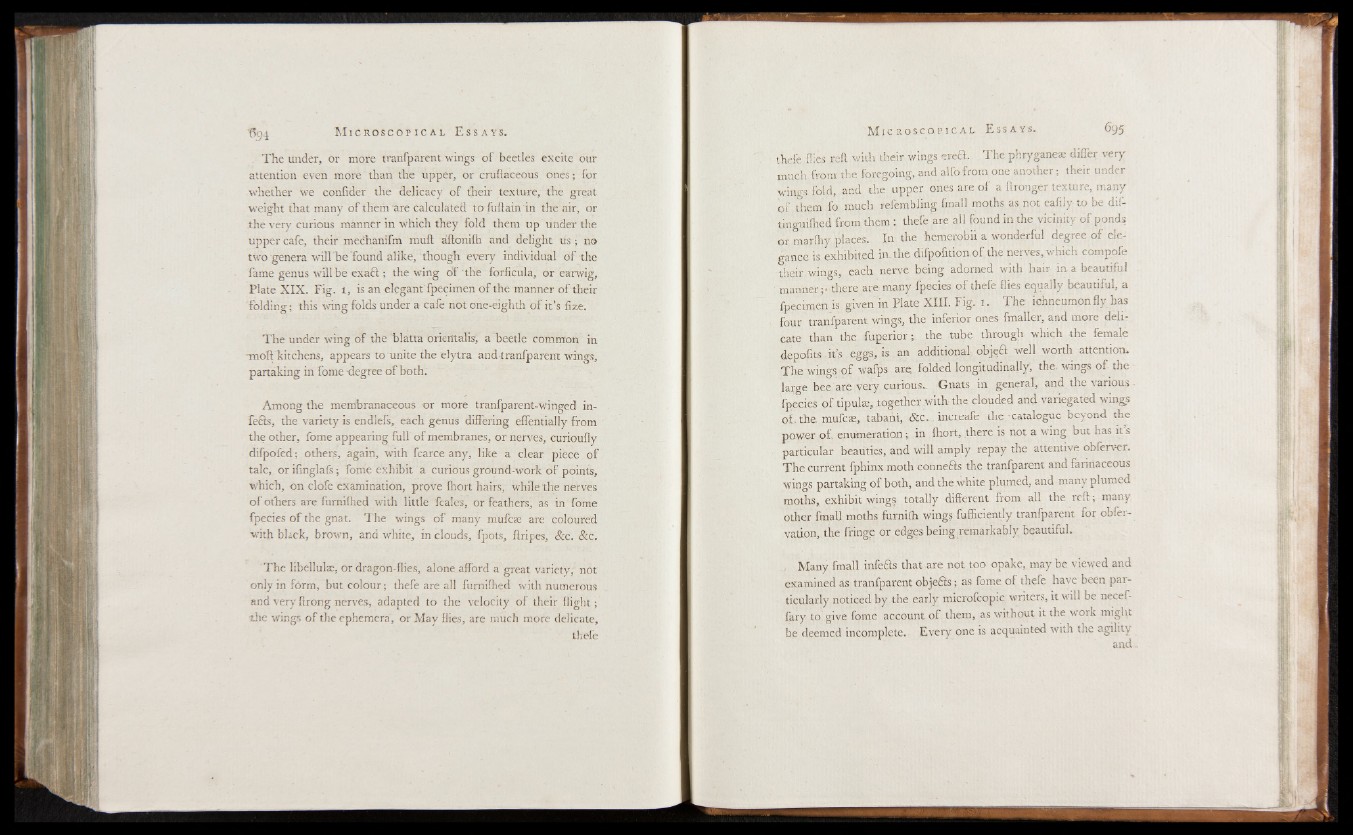
The under, or more tranfparent wings o f beetles excite our
attention even more than the upper, or cruftaceous ones; for
whether we conlider the delicacy of their texture, the great
weight that many o f them are calculated to fuftain in the air, or
the very curious manner in which they fold them up under the
upper cafe, their mechanifm mud afkmifh and delight u s ; ns
two genera will be found alike, though every individual o f the
fame genus will be e x a ft ; the wing o f the forficula, or earwig,
Plate XIX. Fig. i , is an elegant fpecimen o f the manner o f their
folding; this wing folds under a cafe not one-eighth of it’s lize.
The under wing of the “blatta orientally, a beetle common in
•molt kitchens, appears to unite the elytra and tranfparent wings,
partaking in fome -degree o f both.
Among the membranaceous or more tranfparent-winged in-
fefts, the variety is endlefs, each genus differing effentially from
the other, fome appearing full of membranes, or nerves, curioufly
difpofed; others, again, with fcarce any, like a clear piece o f
talc, or ifinglafs; fome exhibit a curious ground-work o f points,
which, on clofe examination, prove fhort hairs, while the nerves
o f others are fumifhed with little fcales, or feathers) as in fome
fpecies o f the gnat. The wings o f many mufcae are coloured
with black, brown, and white, in clouds, fpots, ftripes, &c. &c.
The libellulae, or dragon-flies, alone afford a great variety, not
only in form, but colour; thefe are all furnifhed with numerous
and very flrong nerves, adapted to the velocity of their flight;
the wings o f the ephemera, or May flies, are much more delicate,
thefe
thefe flies reft with their wings ereft. The phryganea: differ very
much from the foregoing, and alfo from one another; their under
wings fold, and the upper ones are of a ftronger texture, many
of them fo much refembling fmall moths as not eafily to be dif-
tinguifhed from them ; thefe are all found in the vicinity o f ponds
or marfhy places. In the hemerobii a wonderful degree o f elegance
is exhibited in.the difpofition o f the nerves, which compofe
their wings, each nerve being adorned with hair in a beautiful
manner;- there are many fpecies of thefe flies equally beautiful, a
fpecimen is given in Plate XIII. Fig, 1. The ichneumon fly has
four tranfparent wings, the inferior ones fmaller, and more delicate
than the fuperior; the tube through which the female
depofits it’s eggs, is an additional objeft well worth attention*
The wings o f wafps are folded longitudinally, the, wings o f the
large bee are very curious.. Gnats in general, and the various-
fpecies of tipulae, together .with-the clouded and variegated wings
of. the, mufcae, tabahi, &c. increafe the catalogue beyond the
power of. enumeration; in fhort, there is not a wing but has it’s
particular beauties, and will amply repay the attentive obferver.
The current fphinx moth connects the tranfparent and farinaceous
wings partaking of both, and the white plumed, and many plumed
moths, exhibit wings totally different from all the reft; many
other fmall moths furnifh wings fufficiently tranfparent for obfer-
vation, the fringe or edges being remarkably beautiful.
Many fmall infefts that are not too opake, may be viewed and
examined as tranfparent objefts; as fome of thefe have been particularly
noticed by the early microfcopic writers, it will be necef-
fary to give fome account o f them, as without it the work might
be deemed incomplete. Every one is acquainted with the agility
and